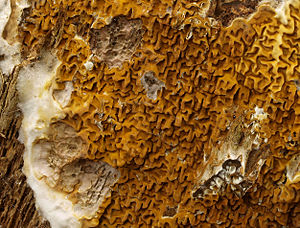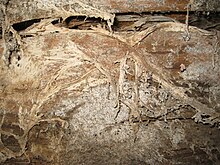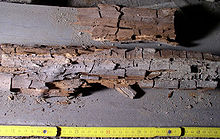Dry rot
| Dry rot | ||||||||||||
|---|---|---|---|---|---|---|---|---|---|---|---|---|

Wild dry rot ( Serpula himantioides ) |
||||||||||||
| Systematics | ||||||||||||
|
||||||||||||
| Scientific name | ||||||||||||
| Serpula | ||||||||||||
| ( Pers. ) Gray |
The house sponges ( Serpula ) are a genus of fungus from the family of the brown spider bark fungus relatives ; Despite its flat, the substrate resting fruiting body they belong to the order of Dickröhrlingsartigen (Boletales).
The type species is Merulius destruens .
features
The house sponges form resupinate (attached to the substrate) to effuso-reflexe (protruding from the substrate at the edges) fleshy to waxy fruiting bodies , the surface of which is wrinkled and wrinkled, in some species also stubble or irregularly pored. The double-walled spores are spherical to ellipsoid, they are yellowish to brown in color.
ecology
The house sponges are saprobiontic wood dwellers that produce an intense brown rot in the affected wood.
species
The genus contains 15 species worldwide, 2 of which occur in Europe:
| German name | Scientific name | Author quote |
|---|---|---|
| Wild dry rot | Serpula himantioides | (Fries 1818: Fries 1821) P. Karsten 1884 |
| Real or watery dry rot | Serpula lacrymans | (Wulfen 1781: Fries 1821) P. Karsten 1884 |
meaning
The real dry rot , in particular, is an important and feared wood pest because, in contrast to most other types of fungus found in buildings (such as the brown cellar sponge ), it is able to grow many meters through masonry.
It is customary to remove all wooden structures within at least one meter of visible infestation in order to remove mycelium that is invisible beneath the surface. Infested masonry should be scorched and treated with fungicide .
In addition to wood, the fungus can also be found on other organic materials such as a. Textiles, paper, chipboard, straw and reeds are good conditions for growth.
swell
literature
- Heinrich Dörfelt , Gottfried Jetschke (Ed.): Dictionary of mycology. 2nd Edition. Spectrum Academic Publishing House, Heidelberg / Berlin 2001, ISBN 3-8274-0920-9 .
- Achim Bollmann, Andreas Gminder , Peter Reil: List of illustrations of large European mushrooms . In: Yearbook of the Black Forest mushroom teaching show . 4th edition. Volume 2. Schwarzwälder Pilzlehrschau, 2007, ISSN 0932-920X (301 pages; directory of the color images of almost all large European mushrooms (> 5 mm) incl. CD with over 600 species descriptions).
- German Josef Krieglsteiner (Ed.): The large mushrooms of Baden-Württemberg . Volume 1: General Part. Stand mushrooms: jelly, bark, prick and pore mushrooms. Ulmer, Stuttgart 2000, ISBN 3-8001-3528-0 .
Individual evidence
- ^ Christian Hendrik Persoon , George Heinrich Leunemann: Merulius sect. Serpula . In: Synopsis methodica fungorum . Apud H. Dieterich, 1801, p. 496 ( available online - 706 pages).
- ↑ Eric Strittmatter: The genus Serpula . In: fungiworld.com. Mushroom Taxa Database. Retrieved July 9, 2012 .
Web links
- Fungus: Dry rot uses chemical club against wood. A chemical reaction helps the fungus break down the hard ligin. University of Jena, August 22, 2011, accessed on July 9, 2012 (Science, 2011, doi : 10.1126 / science.1205411 ).


